MageLords Preview
Take a behind-the-scenes look at the development of this fantasy-themed RTS.
While Kinesoft has been developing technology for use in other companies' games since 1991, it only recently began working on its own games. In the summer of 2001, it plans to release two innovative real-time strategy games; each set in its own unique universe and each with a unique style of play. Kinesoft hopes that each game's unique gameplay will not only make them stand out against fierce competition in the real-time strategy genre but will also create a standard against which future RTS games will be compared. The first, Crimson Order, is a real-time third-person tactical game set in a sci-fi universe, which we previewed
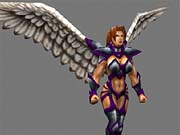
The world of MageLords was first ruled by a civilization known as Arcan, which was made up of six distinct clans. Each clan had a representative in Arcan's ruling council, which governed all aspects of society. Over time, the council focused its efforts on harnessing the power of the magic that permeated its world. Each member of the council selected one of the six magical disciplines to study: good, evil, order, chaos, nature, and the nexus. The council adopted the title of MageLords and soon became distrustful of one another. The council's mistrust quickly led to battle and plunged the Arcanian society into 300 years of war.

In the midst of the war, the MageLords became aware of the presence of another force, the Asthorra. This evil force had been imprisoned for thousands of years within a great sphere that contained the history of Arcan and all the knowledge of the MageLords. The Asthorra was subtly influencing the MageLords through the sphere, and the MageLords united against it in an effort to destroy the sphere and trap the Asthorra. Although they successfully destroyed the sphere, they realized too late that they had been tricked into setting off an explosion of magical energy that would alter the course of evolution for the six clans and eventually lead to the return of the Asthorra.
The game takes place many years after the sphere was destroyed. The six clans have evolved into distinct races: humans, elves, dwarves, giants, wraith lords, and boggins. The clans have grown to hate one another. Members of each clan have worked to become new MageLords and learn the ways of magic. While the MageLords are equally powerful in their specific spheres of magic, their motives differ. Some wish to expand their empire through conquest and battle, some want only to use their power for revenge, and some hope to once again reunite the clans and rebuild the ancient Arcan civilization.
The Game
The development team at Kinesoft believes that most recent real-time strategy games are built on the same formula so that if you've played one of them, you can jump right in to any other game and know your way around. While this formulaic approach to games reduces the time spent learning new games, it also reduces the overall novelty and sense of fun. Most real-time strategy games available today are really about battles, rather than a full-scale campaign. Kinesoft set out to create a new type of real-time strategy game and built MageLords from the ground up to be a real-time campaign-based fantasy epic. Players are meant to feel that each individual battle is part of a larger campaign, rather than a preset encounter between two groups of opposing units.
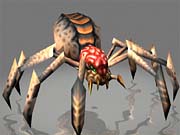
To this end, the game is based on a large-scale strategic 3D map on which you can give broad orders and run the overall campaign. As encounters take place, you can then zoom in on the battle and directly control up to ten units consisting of one or more creatures on a tactical 3D battlefield. Each battle can include up to 100 creatures per side. You also have the option to control a single creature instead of an entire group, although the focus of the game is on tactics, and group control is more effective in most situations.
The strategic maps are randomly generated, but tactical maps are hand-built in order to offer a better battle experience. Around ten tactical maps for each type of terrain will be included, and the game will select from that pool of premade maps. Terrain types include plains, forest, mountains, swamp, desert, and several others.
The game features a wide variety of creatures, including dragons, minotaurs, zombies, basilisks, skeleton warriors, death knights, hellhounds, and wraiths. While many creatures belong to one of the six main races in the game, others are neutral. Neutral creatures can exist in the world due to the work of the ancient evil force, the Asthorra, or they can merely be random wandering monsters. The six races in the game each have different strengths and weaknesses. Although many of the races are found in traditional fantasy stories, the team at Kinesoft has also created an entirely new race.
Humans: This race is the least physically adapted race and is, as a result, the most dependent on teamwork and the effective use of units to defeat its opponents. The armored knight is a powerful human unit and one of the most potent units on the battlefield.
Elves: Although those that make up this agricultural race wear little armor, their skill with the longbow makes them a particularly effective race at long range. The elfin warrior is the most deadly long-range attack unit in the game.
Dwarves: The dwarven race has unmatched production facilities and skill in building. This race creates the best city defenses and relies on heavily armored units in battle. Their armies move slowly but contain powerful units such as the steam tank.
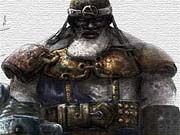
Giants: This race dwells in the frigid hills in the north. They tend to be solitary creatures, are extremely large, and extremely powerful, but as a result of their size they require more resources to support their armies.
Wraith Lords: These creatures are skilled in the art of dark magic, and they summon armies of undead creatures such as zombies and skeletons to do battle against their enemies.
Boggins: This race was created specifically for the MageLords' universe by the design team at Kinesoft. The boggins are scavengers that live in the swamp. Although the individual creatures are weak and small, they make up for their small size by reproducing quickly and overwhelming their enemies with sheer numbers. They are also skilled at training swamp-dwelling creatures, such as raptors, for use in their armies, which they often ride into battle. The giant draak spiders are fearsome creatures also used by the boggins.
The Interface
Rather than employ the typical, flat menu-style interface found in many strategy games, Kinesoft has created a unique 3D "mage lab" in which the player can navigate through the game and find all necessary information. The mage lab adds an enjoyable aspect to the game; this new interface gives you a sense of what it would really be like to be a MageLord, with the responsibility of running a campaign from the safety of your fortress. The lab consists of a room filled with a variety of useful items, each of which corresponds directly to a game feature. In order to enter the strategic mode, for instance, you need only consult the large map on the table and zoom in on individual battles to access the tactical mode. To research new spells, a number of spell books are available, and a crystal ball lets you talk to the enemy mages. By selecting the various items around the lab, you can remain within the world of MageLords, rather than jumping back out every time you need to switch between game modes.
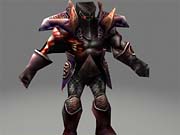
Both the strategic and the tactical maps run in real time, but the pace differs significantly. Each skirmish is over within a single day of game time in the tactical mode, while it may take an army a week or more of game time to move from one city to the next in strategic mode. The idea behind the two modes is to let the player participate in every battle while still controlling the overall campaign. If two battles happen simultaneously, you need only choose one to zoom in on first, and, after the completion of that battle, you can zoom in on the other. Although this method of battle management may not be realistic, the developers felt it important to let players oversee each individual battle, rather than force them to choose between battles. In addition, this interface lets you focus entirely on tactical concerns during a battle and not worry about strategic concerns such as building, resource management, and research between encounters.
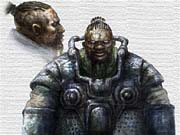
The development team is currently working on translating the concept sketches covering the walls of the company's hallways into fully 3D models, which will then be animated and used in the game. Each unit will be faithfully recreated in 3D according to the original concept sketch. The team decided not to use motion-capture technology because of the nature of many of the fantasy creatures. "It's so hard to get those sensors to stick to the legs of a spider," according to one member of the team. Nevertheless, the units that appeared in the demonstration build of the game were realistically animated, and they smoothly performed a number of different movements. Rather than using a single hacking motion to indicate an attack, the units executed a number of moves, including slashes, thrusts, and blocks, to make it look as if they were actually fighting.
The relative size of each unit is faithfully depicted. Giants appear far larger than elves, for instance, and exude the kind of power a giant should have, convincingly pummeling the smaller units that crowd around in a desperate attempt to defeat the monster. Some special units, such as the guardian, also have specific skills. The guardian unit creates a sphere around itself that will protect any nearby units from enemy spells.
Final Thoughts
As a MageLord, you not only control armies but also have the power to cast offensive and defensive spells, both on a tactical and on a strategic scale. Each spell is depicted on screen with an appropriate particle effect. Many of the spells are very impressive: Tactical spells such as ringfire, tornado, and lightning can cause damage to enemy units directly, while a defensive spell such as firewall can keep enemy units from attacking. Strategic spells such as plague or darkness can cause harm to an enemy on a broader scale, while a spell like summon will attract additional creatures for the MageLord's army.
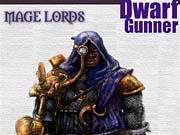
The game is intentionally made up of a wide variety of fairly simple elements. Units in armies tend to be fairly straightforward, and spells have directly understandable effects. The philosophy behind this underlying simplicity is that the game itself should not contain complexity in itself, but rather generate complexity through the interaction of simple parts. Like in the game of chess where the pieces have simple moves but can in combination produce incredible results, MageLords is designed to let you form your own strategies using a simple set of parts.
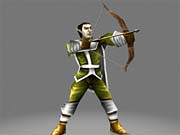
While this theory sounds artless, it is far more difficult to achieve in practice, as can be seen in the scores of mediocre games released every year. Kinesoft is well aware of the challenge and is focused on balancing the game so that each time you play, you will discover something new. You will enter the battle believing you cannot lose but will soon find that there was something you did not anticipate. The developer has assembled a talented team to create the game and is confident that it will be able to carefully balance the game to create the desired effect. If everything goes according to Kinesoft's plan, real-time strategy fans will have a new favorite game next summer.
Got a news tip or want to contact us directly? Email news@gamespot.com
Join the conversation